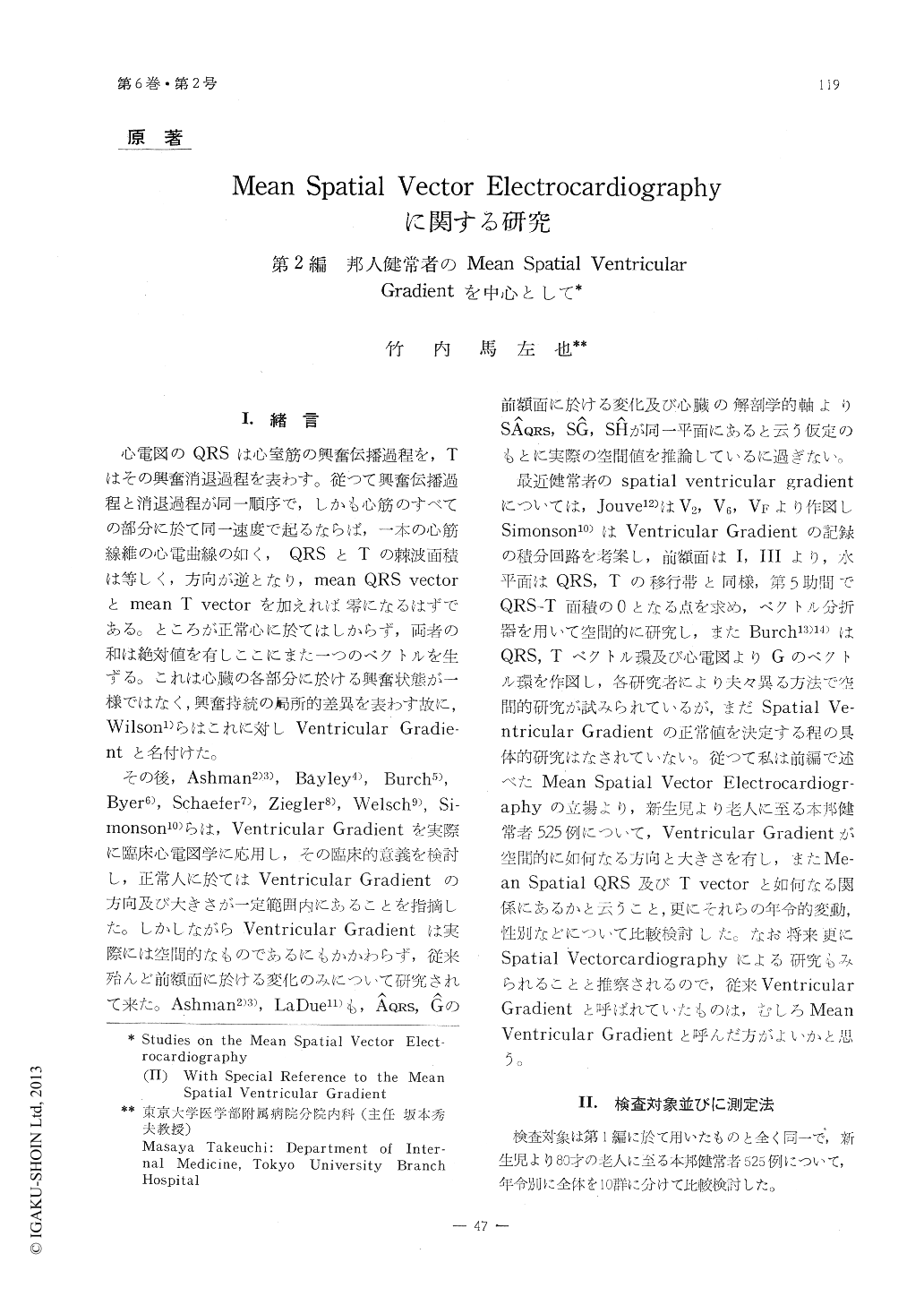Japanese
English
- 有料閲覧
- Abstract 文献概要
- 1ページ目 Look Inside
I.緒言
心電図のQRSは心室筋の興奮伝播過程を,Tはその興奮消退過程を表わす。従つて興奮伝播過程と消退過程が同一順序で,しかも心筋のすべての部分に於て同一速度で起るならば,一本の心筋線維の心電曲線の如く,QRSとTの棘波面積は等しく,方向が逆となり,mean QRS vectorとmean T vectorを加えれば零になるはずである。ところが正常心に於てはしからず,両者の和は絶対値を有しここにまた一つのベクトルを生ずる。これは心臓の各部分に於ける興奮状態が一様ではなく,興奮持統の局所的差異を表わす故に,Wilson1)らはこれに対しVentricular Gradie—ntと名付けた。
その後,Ashman2)3),Bayley4),Burch5),Byer6),Schaefer7),Ziegler8),Welsch9),Si—monson10)らは,Ventricular Gradientを実際に臨床心電図学に応用し,その臨床的意義を検討し,正常人に於てはVentricular Gradientの方向及び大きさが一定範囲内にあることを指摘した。しかしながらVentricular Gradientは実際には空間的なものであるにもかかわらず,従来殆んど前額面に於ける変化のみについて研究されて来た。
The magnitude and direction of the mean spatial ventricular gradient (SĜ) were calculated by means of the parallelogram law from SÂQRS and SÂT as described in the first report, and the- relations of SĜ to SÂQRS and SÂT were investigated. All items of vector analysis were compared statistically with significant level 0.05 in ten age groups of a total of 525 normal subjects from newborn to 80 years of age. Furthermore, the method of obtaining SĜ and the clinical value of SĜ and the significance of age and sex differences were discussed.
The results obtained are as follows:
1) Normal range in the direction of SĜ is extremely wide, especially in the horizontal plane in newborns and is relatively wide in the frontal and sagittal planes, especially in the sagittal plane after 50 years of age as compared with other age groups.
2) Average direction of SĜ points significantly to the right in newborns and to the left in elderly subjects after 40 years of age as compared with other age groups. SĜ is mostly directed anteriorly in newborns and then posteriorly until adolscence; thereafter, slightly anteriorly in young adults, and slightly posteriorly in elderly subjects.
3) In the frontal plane SĜ lies mostly in the counterclockwise direction of SÂQRS. However, such a tendency decreases according to the increase in age, and finally, SĜ lies mostly in the clokwise direction of SÂQRS after 60 years of age. In the horizontal plane SĜ lies mostly in the counterclockwise direct-ion until 1 year of age; thereafter, SĜ tends to lie mostly in the clockwise direction of SÂQRS and such a tendency increases according to the increase in age.
4) The maguitude of SĜ is smallest in newborns and then increased according to age until adoles cence which shows the maximum value. Thereafter, the variation is not statistically significant.
5) The angle between SÂQRS and SĜ {∠(SÂQRS・SĜ)} is remarkably large in newborns but there-after, it is decreased significantly. After childhood it retains almost constant average values until elderly subjects. The angle between SÂT and SĜ {∠(SÂT・SĜ)} shows the same age trend as ∠(SÂQRS ・SĜ), but it is increased significantly in elderly subjects after 60 years of age as compared with young adults: The normal ranges of these angles are smaller than the range of the direction of SĜ
6) ∠(SÂQRS・SĜ) and the magnitude of SĜ are significantly larger in male than in female. ∠(SÂT・SĜ) is slightly larger in male than in female but not statistically significant. Average value of the direction of SĜ lies more to the right and anteriorly in male than in female.

Copyright © 1958, Igaku-Shoin Ltd. All rights reserved.


